Management and Operations Report: Ford Company Analysis and Strategies
VerifiedAdded on 2021/01/01
|10
|3216
|79
Report
AI Summary
This report provides a comprehensive analysis of Ford Motor Company's operations management, leadership styles, and strategic approaches. It defines and compares the roles of leaders and managers, examining their characteristics and responsibilities in various situations. The report explores the application of leadership theories, including situational, contingency, and systems leadership, within Ford's context. It also delves into key approaches to operations management, such as Total Quality Management, Six Sigma, and Lean principles, and discusses the roles of leaders and managers in implementing these approaches. Furthermore, the report highlights the importance and value of operations management in achieving business objectives and assesses the factors within the business environment that impact operational management and decision-making. The analysis provides insights into how Ford can optimize its operations to achieve its goals.
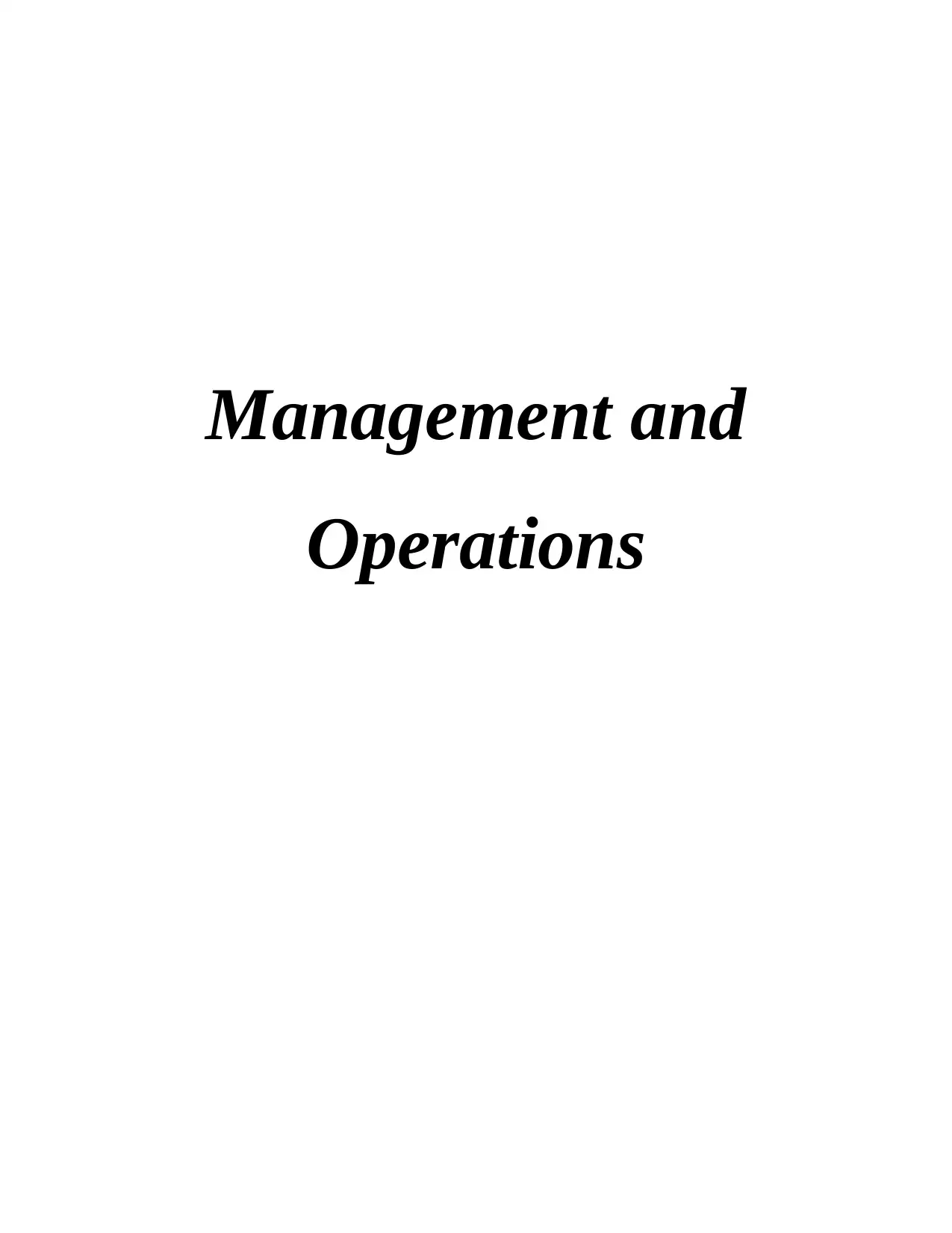
Management and
Operations
Operations
Paraphrase This Document
Need a fresh take? Get an instant paraphrase of this document with our AI Paraphraser
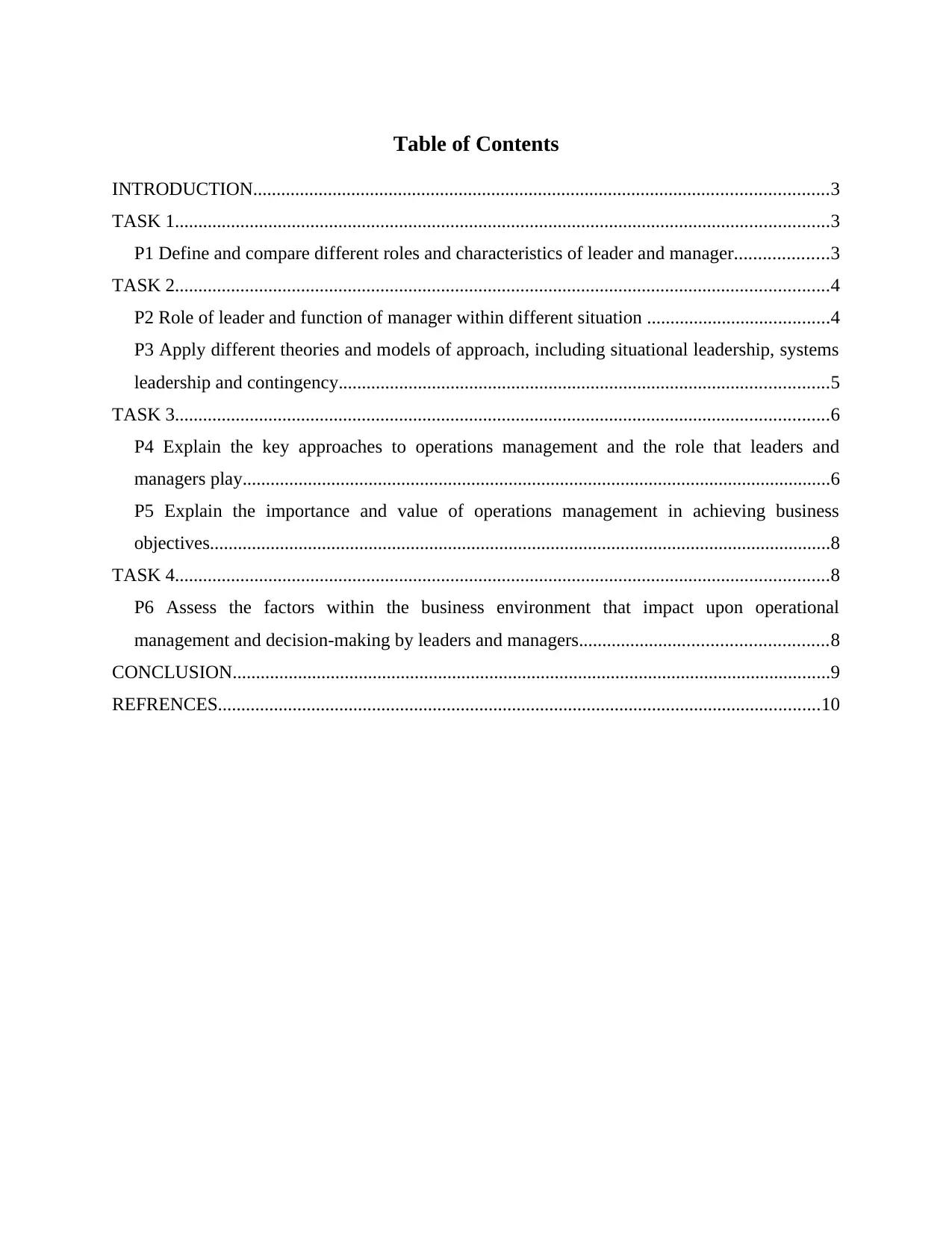
Table of Contents
INTRODUCTION...........................................................................................................................3
TASK 1............................................................................................................................................3
P1 Define and compare different roles and characteristics of leader and manager....................3
TASK 2............................................................................................................................................4
P2 Role of leader and function of manager within different situation .......................................4
P3 Apply different theories and models of approach, including situational leadership, systems
leadership and contingency.........................................................................................................5
TASK 3............................................................................................................................................6
P4 Explain the key approaches to operations management and the role that leaders and
managers play..............................................................................................................................6
P5 Explain the importance and value of operations management in achieving business
objectives.....................................................................................................................................8
TASK 4............................................................................................................................................8
P6 Assess the factors within the business environment that impact upon operational
management and decision-making by leaders and managers.....................................................8
CONCLUSION................................................................................................................................9
REFRENCES.................................................................................................................................10
INTRODUCTION...........................................................................................................................3
TASK 1............................................................................................................................................3
P1 Define and compare different roles and characteristics of leader and manager....................3
TASK 2............................................................................................................................................4
P2 Role of leader and function of manager within different situation .......................................4
P3 Apply different theories and models of approach, including situational leadership, systems
leadership and contingency.........................................................................................................5
TASK 3............................................................................................................................................6
P4 Explain the key approaches to operations management and the role that leaders and
managers play..............................................................................................................................6
P5 Explain the importance and value of operations management in achieving business
objectives.....................................................................................................................................8
TASK 4............................................................................................................................................8
P6 Assess the factors within the business environment that impact upon operational
management and decision-making by leaders and managers.....................................................8
CONCLUSION................................................................................................................................9
REFRENCES.................................................................................................................................10
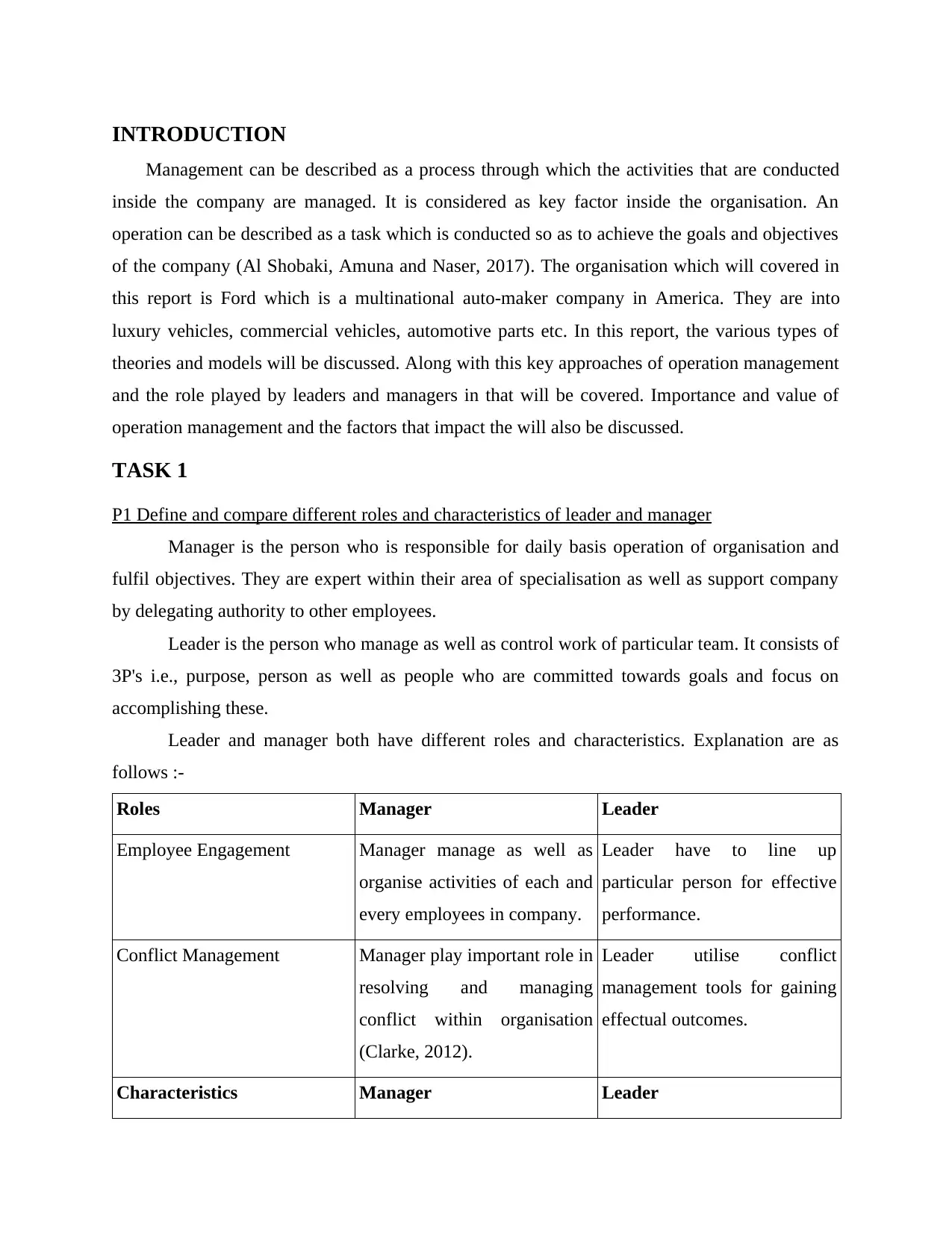
INTRODUCTION
Management can be described as a process through which the activities that are conducted
inside the company are managed. It is considered as key factor inside the organisation. An
operation can be described as a task which is conducted so as to achieve the goals and objectives
of the company (Al Shobaki, Amuna and Naser, 2017). The organisation which will covered in
this report is Ford which is a multinational auto-maker company in America. They are into
luxury vehicles, commercial vehicles, automotive parts etc. In this report, the various types of
theories and models will be discussed. Along with this key approaches of operation management
and the role played by leaders and managers in that will be covered. Importance and value of
operation management and the factors that impact the will also be discussed.
TASK 1
P1 Define and compare different roles and characteristics of leader and manager
Manager is the person who is responsible for daily basis operation of organisation and
fulfil objectives. They are expert within their area of specialisation as well as support company
by delegating authority to other employees.
Leader is the person who manage as well as control work of particular team. It consists of
3P's i.e., purpose, person as well as people who are committed towards goals and focus on
accomplishing these.
Leader and manager both have different roles and characteristics. Explanation are as
follows :-
Roles Manager Leader
Employee Engagement Manager manage as well as
organise activities of each and
every employees in company.
Leader have to line up
particular person for effective
performance.
Conflict Management Manager play important role in
resolving and managing
conflict within organisation
(Clarke, 2012).
Leader utilise conflict
management tools for gaining
effectual outcomes.
Characteristics Manager Leader
Management can be described as a process through which the activities that are conducted
inside the company are managed. It is considered as key factor inside the organisation. An
operation can be described as a task which is conducted so as to achieve the goals and objectives
of the company (Al Shobaki, Amuna and Naser, 2017). The organisation which will covered in
this report is Ford which is a multinational auto-maker company in America. They are into
luxury vehicles, commercial vehicles, automotive parts etc. In this report, the various types of
theories and models will be discussed. Along with this key approaches of operation management
and the role played by leaders and managers in that will be covered. Importance and value of
operation management and the factors that impact the will also be discussed.
TASK 1
P1 Define and compare different roles and characteristics of leader and manager
Manager is the person who is responsible for daily basis operation of organisation and
fulfil objectives. They are expert within their area of specialisation as well as support company
by delegating authority to other employees.
Leader is the person who manage as well as control work of particular team. It consists of
3P's i.e., purpose, person as well as people who are committed towards goals and focus on
accomplishing these.
Leader and manager both have different roles and characteristics. Explanation are as
follows :-
Roles Manager Leader
Employee Engagement Manager manage as well as
organise activities of each and
every employees in company.
Leader have to line up
particular person for effective
performance.
Conflict Management Manager play important role in
resolving and managing
conflict within organisation
(Clarke, 2012).
Leader utilise conflict
management tools for gaining
effectual outcomes.
Characteristics Manager Leader
⊘ This is a preview!⊘
Do you want full access?
Subscribe today to unlock all pages.

Trusted by 1+ million students worldwide
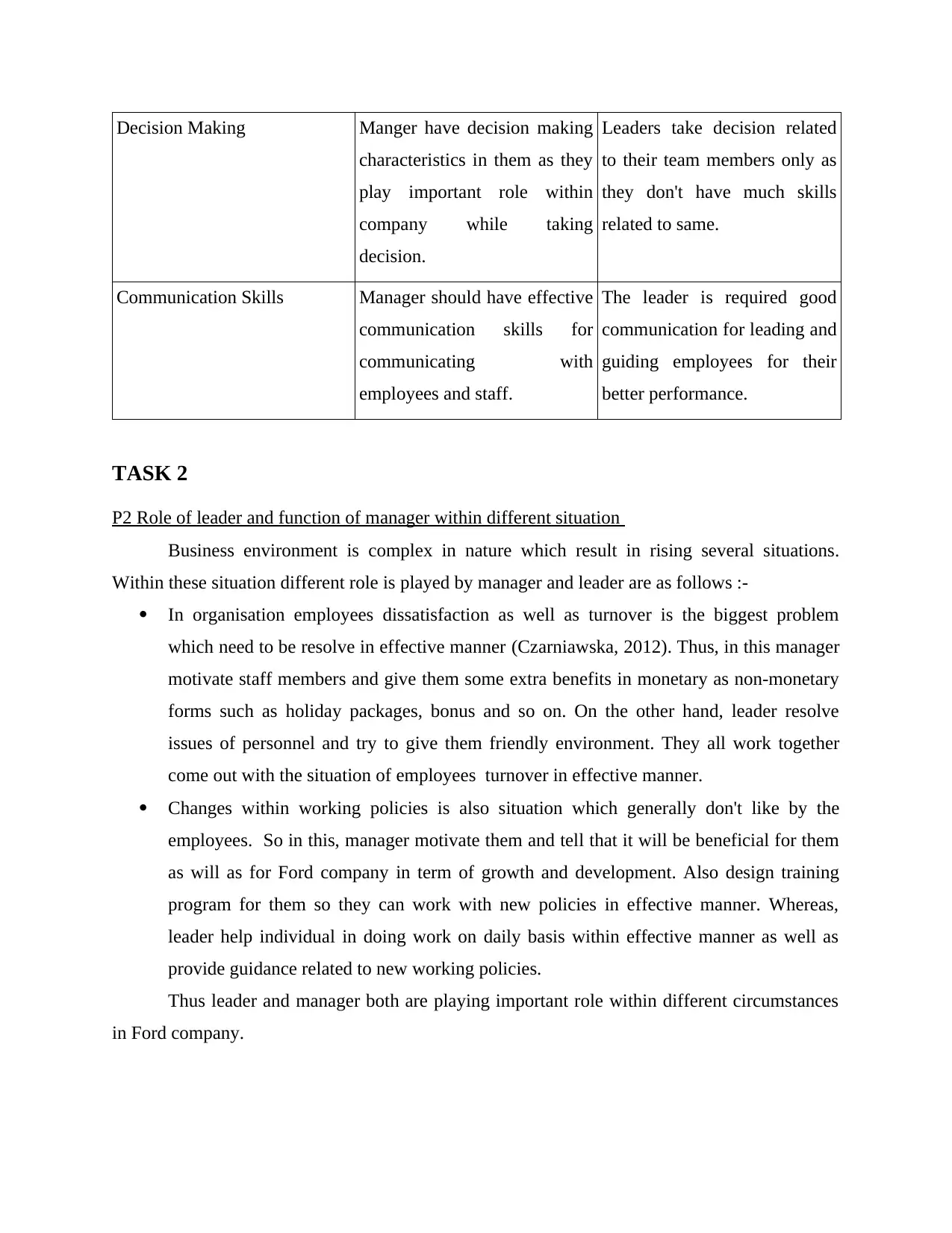
Decision Making Manger have decision making
characteristics in them as they
play important role within
company while taking
decision.
Leaders take decision related
to their team members only as
they don't have much skills
related to same.
Communication Skills Manager should have effective
communication skills for
communicating with
employees and staff.
The leader is required good
communication for leading and
guiding employees for their
better performance.
TASK 2
P2 Role of leader and function of manager within different situation
Business environment is complex in nature which result in rising several situations.
Within these situation different role is played by manager and leader are as follows :-
In organisation employees dissatisfaction as well as turnover is the biggest problem
which need to be resolve in effective manner (Czarniawska, 2012). Thus, in this manager
motivate staff members and give them some extra benefits in monetary as non-monetary
forms such as holiday packages, bonus and so on. On the other hand, leader resolve
issues of personnel and try to give them friendly environment. They all work together
come out with the situation of employees turnover in effective manner.
Changes within working policies is also situation which generally don't like by the
employees. So in this, manager motivate them and tell that it will be beneficial for them
as will as for Ford company in term of growth and development. Also design training
program for them so they can work with new policies in effective manner. Whereas,
leader help individual in doing work on daily basis within effective manner as well as
provide guidance related to new working policies.
Thus leader and manager both are playing important role within different circumstances
in Ford company.
characteristics in them as they
play important role within
company while taking
decision.
Leaders take decision related
to their team members only as
they don't have much skills
related to same.
Communication Skills Manager should have effective
communication skills for
communicating with
employees and staff.
The leader is required good
communication for leading and
guiding employees for their
better performance.
TASK 2
P2 Role of leader and function of manager within different situation
Business environment is complex in nature which result in rising several situations.
Within these situation different role is played by manager and leader are as follows :-
In organisation employees dissatisfaction as well as turnover is the biggest problem
which need to be resolve in effective manner (Czarniawska, 2012). Thus, in this manager
motivate staff members and give them some extra benefits in monetary as non-monetary
forms such as holiday packages, bonus and so on. On the other hand, leader resolve
issues of personnel and try to give them friendly environment. They all work together
come out with the situation of employees turnover in effective manner.
Changes within working policies is also situation which generally don't like by the
employees. So in this, manager motivate them and tell that it will be beneficial for them
as will as for Ford company in term of growth and development. Also design training
program for them so they can work with new policies in effective manner. Whereas,
leader help individual in doing work on daily basis within effective manner as well as
provide guidance related to new working policies.
Thus leader and manager both are playing important role within different circumstances
in Ford company.
Paraphrase This Document
Need a fresh take? Get an instant paraphrase of this document with our AI Paraphraser
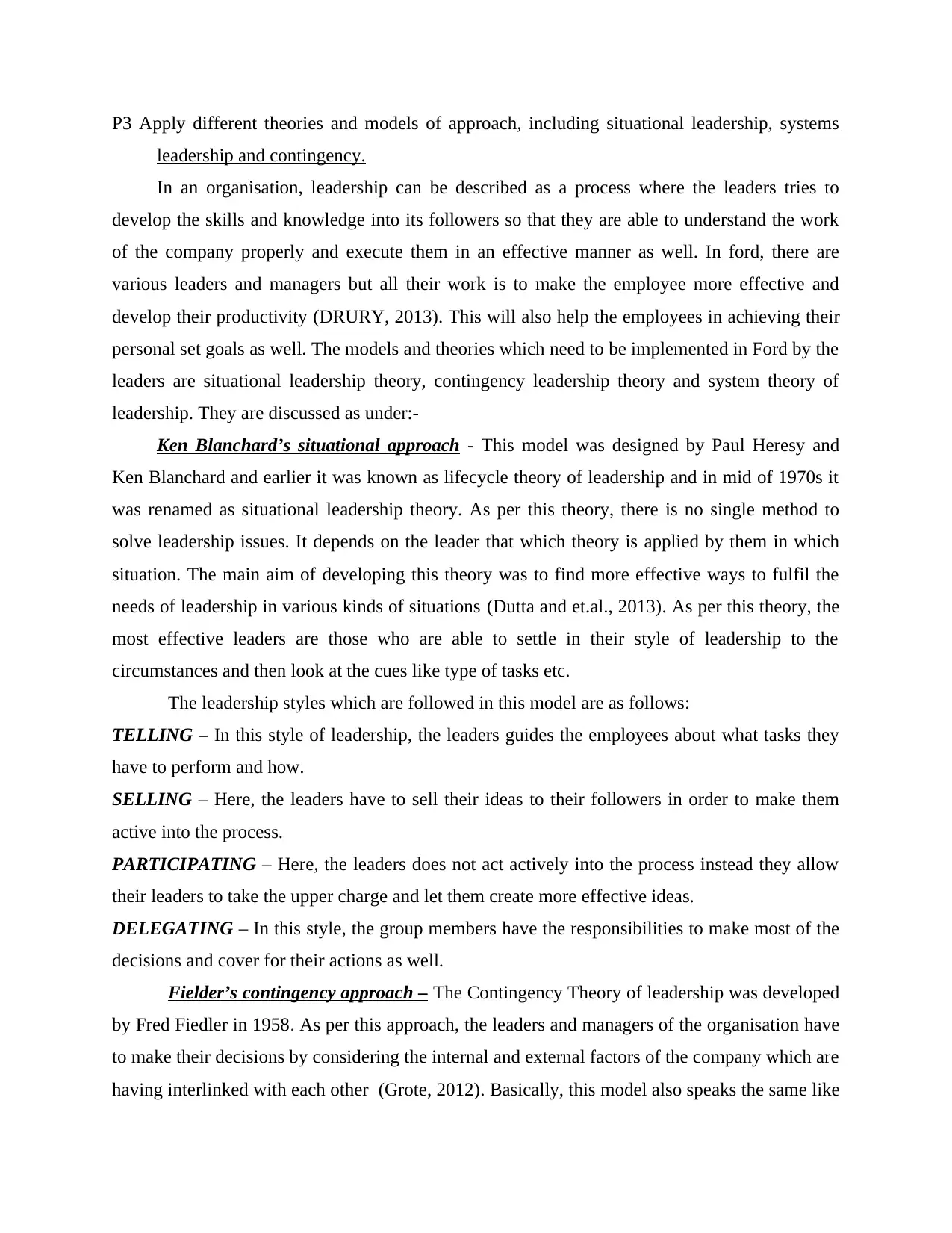
P3 Apply different theories and models of approach, including situational leadership, systems
leadership and contingency.
In an organisation, leadership can be described as a process where the leaders tries to
develop the skills and knowledge into its followers so that they are able to understand the work
of the company properly and execute them in an effective manner as well. In ford, there are
various leaders and managers but all their work is to make the employee more effective and
develop their productivity (DRURY, 2013). This will also help the employees in achieving their
personal set goals as well. The models and theories which need to be implemented in Ford by the
leaders are situational leadership theory, contingency leadership theory and system theory of
leadership. They are discussed as under:-
Ken Blanchard’s situational approach - This model was designed by Paul Heresy and
Ken Blanchard and earlier it was known as lifecycle theory of leadership and in mid of 1970s it
was renamed as situational leadership theory. As per this theory, there is no single method to
solve leadership issues. It depends on the leader that which theory is applied by them in which
situation. The main aim of developing this theory was to find more effective ways to fulfil the
needs of leadership in various kinds of situations (Dutta and et.al., 2013). As per this theory, the
most effective leaders are those who are able to settle in their style of leadership to the
circumstances and then look at the cues like type of tasks etc.
The leadership styles which are followed in this model are as follows:
TELLING – In this style of leadership, the leaders guides the employees about what tasks they
have to perform and how.
SELLING – Here, the leaders have to sell their ideas to their followers in order to make them
active into the process.
PARTICIPATING – Here, the leaders does not act actively into the process instead they allow
their leaders to take the upper charge and let them create more effective ideas.
DELEGATING – In this style, the group members have the responsibilities to make most of the
decisions and cover for their actions as well.
Fielder’s contingency approach – The Contingency Theory of leadership was developed
by Fred Fiedler in 1958. As per this approach, the leaders and managers of the organisation have
to make their decisions by considering the internal and external factors of the company which are
having interlinked with each other (Grote, 2012). Basically, this model also speaks the same like
leadership and contingency.
In an organisation, leadership can be described as a process where the leaders tries to
develop the skills and knowledge into its followers so that they are able to understand the work
of the company properly and execute them in an effective manner as well. In ford, there are
various leaders and managers but all their work is to make the employee more effective and
develop their productivity (DRURY, 2013). This will also help the employees in achieving their
personal set goals as well. The models and theories which need to be implemented in Ford by the
leaders are situational leadership theory, contingency leadership theory and system theory of
leadership. They are discussed as under:-
Ken Blanchard’s situational approach - This model was designed by Paul Heresy and
Ken Blanchard and earlier it was known as lifecycle theory of leadership and in mid of 1970s it
was renamed as situational leadership theory. As per this theory, there is no single method to
solve leadership issues. It depends on the leader that which theory is applied by them in which
situation. The main aim of developing this theory was to find more effective ways to fulfil the
needs of leadership in various kinds of situations (Dutta and et.al., 2013). As per this theory, the
most effective leaders are those who are able to settle in their style of leadership to the
circumstances and then look at the cues like type of tasks etc.
The leadership styles which are followed in this model are as follows:
TELLING – In this style of leadership, the leaders guides the employees about what tasks they
have to perform and how.
SELLING – Here, the leaders have to sell their ideas to their followers in order to make them
active into the process.
PARTICIPATING – Here, the leaders does not act actively into the process instead they allow
their leaders to take the upper charge and let them create more effective ideas.
DELEGATING – In this style, the group members have the responsibilities to make most of the
decisions and cover for their actions as well.
Fielder’s contingency approach – The Contingency Theory of leadership was developed
by Fred Fiedler in 1958. As per this approach, the leaders and managers of the organisation have
to make their decisions by considering the internal and external factors of the company which are
having interlinked with each other (Grote, 2012). Basically, this model also speaks the same like
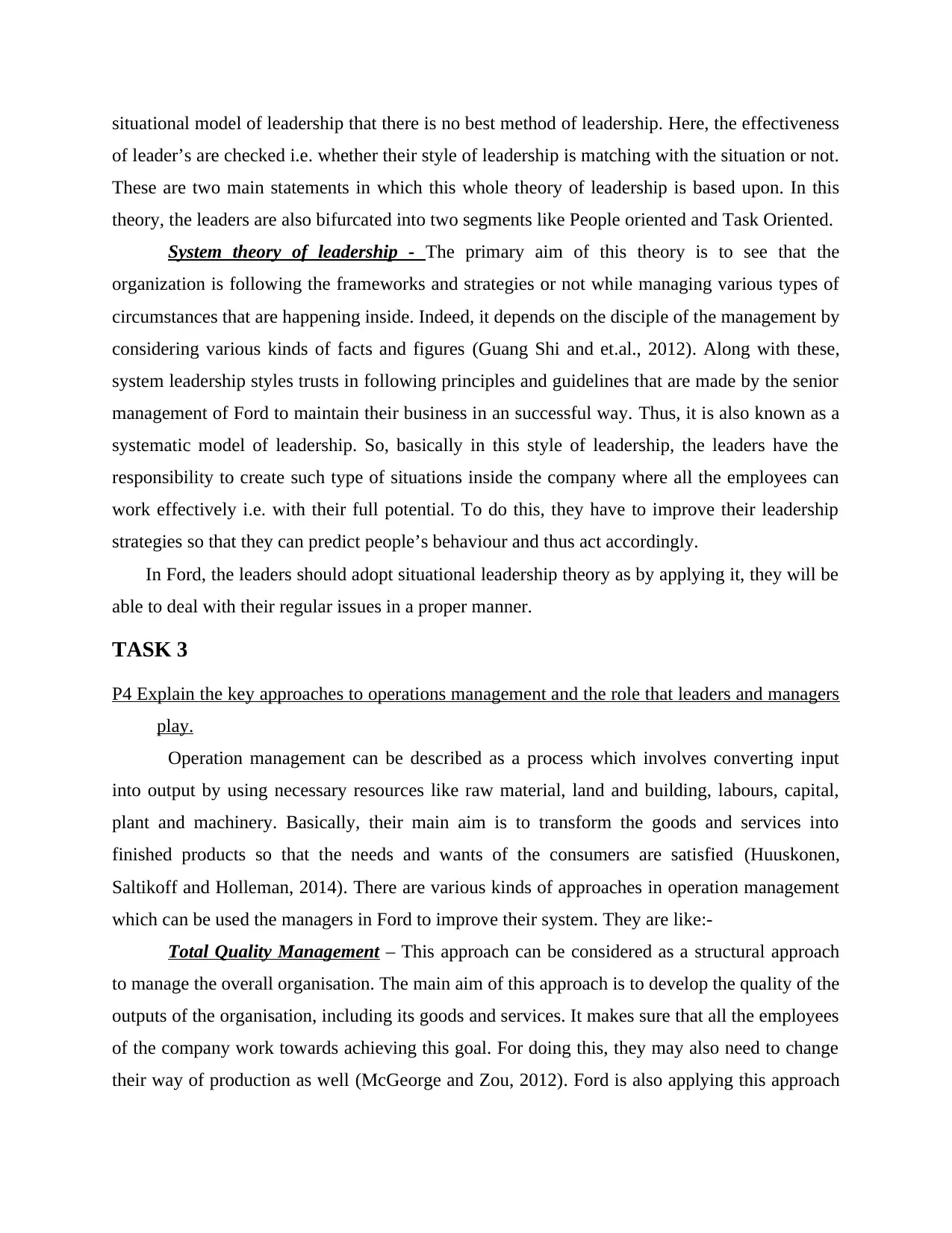
situational model of leadership that there is no best method of leadership. Here, the effectiveness
of leader’s are checked i.e. whether their style of leadership is matching with the situation or not.
These are two main statements in which this whole theory of leadership is based upon. In this
theory, the leaders are also bifurcated into two segments like People oriented and Task Oriented.
System theory of leadership - The primary aim of this theory is to see that the
organization is following the frameworks and strategies or not while managing various types of
circumstances that are happening inside. Indeed, it depends on the disciple of the management by
considering various kinds of facts and figures (Guang Shi and et.al., 2012). Along with these,
system leadership styles trusts in following principles and guidelines that are made by the senior
management of Ford to maintain their business in an successful way. Thus, it is also known as a
systematic model of leadership. So, basically in this style of leadership, the leaders have the
responsibility to create such type of situations inside the company where all the employees can
work effectively i.e. with their full potential. To do this, they have to improve their leadership
strategies so that they can predict people’s behaviour and thus act accordingly.
In Ford, the leaders should adopt situational leadership theory as by applying it, they will be
able to deal with their regular issues in a proper manner.
TASK 3
P4 Explain the key approaches to operations management and the role that leaders and managers
play.
Operation management can be described as a process which involves converting input
into output by using necessary resources like raw material, land and building, labours, capital,
plant and machinery. Basically, their main aim is to transform the goods and services into
finished products so that the needs and wants of the consumers are satisfied (Huuskonen,
Saltikoff and Holleman, 2014). There are various kinds of approaches in operation management
which can be used the managers in Ford to improve their system. They are like:-
Total Quality Management – This approach can be considered as a structural approach
to manage the overall organisation. The main aim of this approach is to develop the quality of the
outputs of the organisation, including its goods and services. It makes sure that all the employees
of the company work towards achieving this goal. For doing this, they may also need to change
their way of production as well (McGeorge and Zou, 2012). Ford is also applying this approach
of leader’s are checked i.e. whether their style of leadership is matching with the situation or not.
These are two main statements in which this whole theory of leadership is based upon. In this
theory, the leaders are also bifurcated into two segments like People oriented and Task Oriented.
System theory of leadership - The primary aim of this theory is to see that the
organization is following the frameworks and strategies or not while managing various types of
circumstances that are happening inside. Indeed, it depends on the disciple of the management by
considering various kinds of facts and figures (Guang Shi and et.al., 2012). Along with these,
system leadership styles trusts in following principles and guidelines that are made by the senior
management of Ford to maintain their business in an successful way. Thus, it is also known as a
systematic model of leadership. So, basically in this style of leadership, the leaders have the
responsibility to create such type of situations inside the company where all the employees can
work effectively i.e. with their full potential. To do this, they have to improve their leadership
strategies so that they can predict people’s behaviour and thus act accordingly.
In Ford, the leaders should adopt situational leadership theory as by applying it, they will be
able to deal with their regular issues in a proper manner.
TASK 3
P4 Explain the key approaches to operations management and the role that leaders and managers
play.
Operation management can be described as a process which involves converting input
into output by using necessary resources like raw material, land and building, labours, capital,
plant and machinery. Basically, their main aim is to transform the goods and services into
finished products so that the needs and wants of the consumers are satisfied (Huuskonen,
Saltikoff and Holleman, 2014). There are various kinds of approaches in operation management
which can be used the managers in Ford to improve their system. They are like:-
Total Quality Management – This approach can be considered as a structural approach
to manage the overall organisation. The main aim of this approach is to develop the quality of the
outputs of the organisation, including its goods and services. It makes sure that all the employees
of the company work towards achieving this goal. For doing this, they may also need to change
their way of production as well (McGeorge and Zou, 2012). Ford is also applying this approach
⊘ This is a preview!⊘
Do you want full access?
Subscribe today to unlock all pages.

Trusted by 1+ million students worldwide
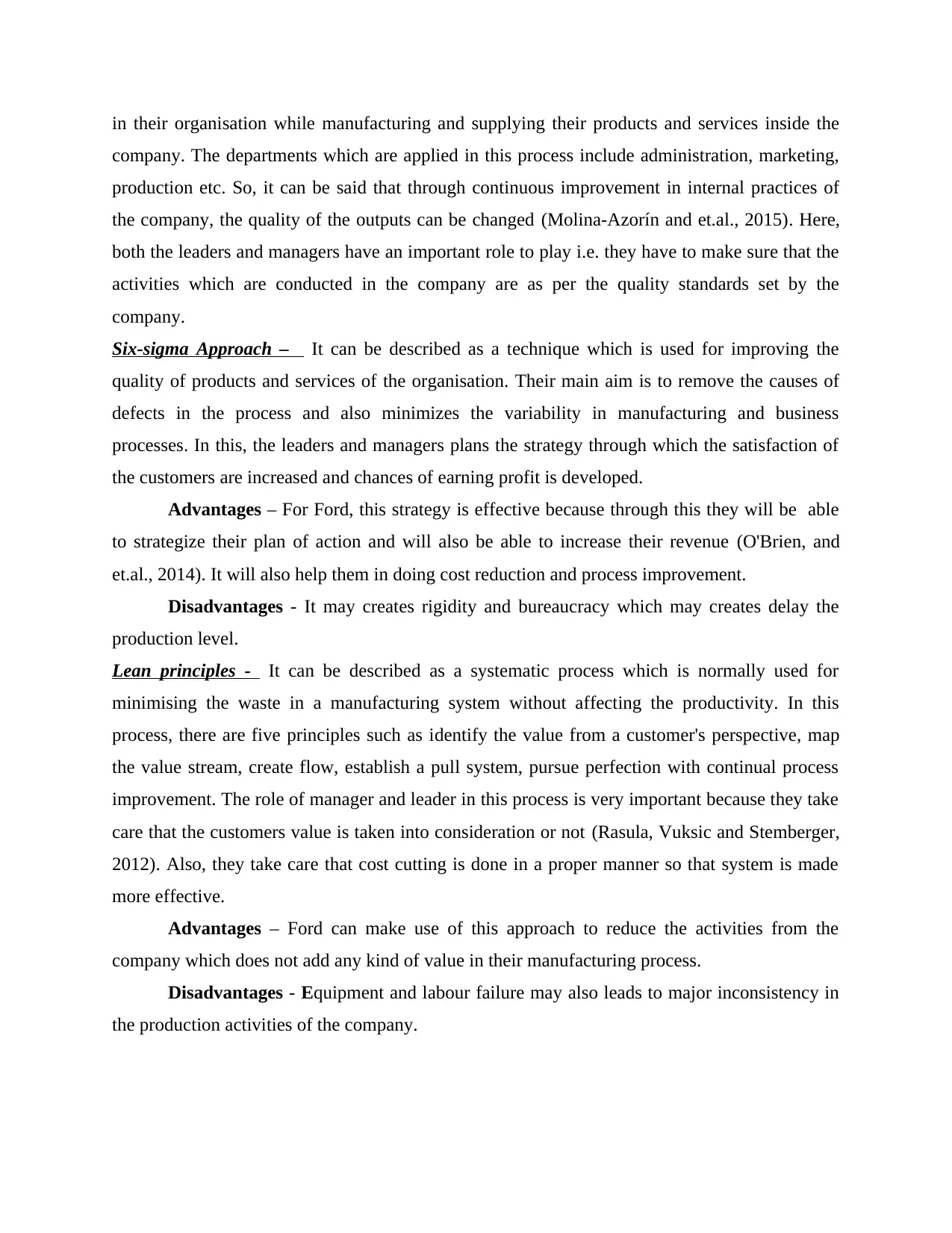
in their organisation while manufacturing and supplying their products and services inside the
company. The departments which are applied in this process include administration, marketing,
production etc. So, it can be said that through continuous improvement in internal practices of
the company, the quality of the outputs can be changed (Molina-Azorín and et.al., 2015). Here,
both the leaders and managers have an important role to play i.e. they have to make sure that the
activities which are conducted in the company are as per the quality standards set by the
company.
Six-sigma Approach – It can be described as a technique which is used for improving the
quality of products and services of the organisation. Their main aim is to remove the causes of
defects in the process and also minimizes the variability in manufacturing and business
processes. In this, the leaders and managers plans the strategy through which the satisfaction of
the customers are increased and chances of earning profit is developed.
Advantages – For Ford, this strategy is effective because through this they will be able
to strategize their plan of action and will also be able to increase their revenue (O'Brien, and
et.al., 2014). It will also help them in doing cost reduction and process improvement.
Disadvantages - It may creates rigidity and bureaucracy which may creates delay the
production level.
Lean principles - It can be described as a systematic process which is normally used for
minimising the waste in a manufacturing system without affecting the productivity. In this
process, there are five principles such as identify the value from a customer's perspective, map
the value stream, create flow, establish a pull system, pursue perfection with continual process
improvement. The role of manager and leader in this process is very important because they take
care that the customers value is taken into consideration or not (Rasula, Vuksic and Stemberger,
2012). Also, they take care that cost cutting is done in a proper manner so that system is made
more effective.
Advantages – Ford can make use of this approach to reduce the activities from the
company which does not add any kind of value in their manufacturing process.
Disadvantages - Equipment and labour failure may also leads to major inconsistency in
the production activities of the company.
company. The departments which are applied in this process include administration, marketing,
production etc. So, it can be said that through continuous improvement in internal practices of
the company, the quality of the outputs can be changed (Molina-Azorín and et.al., 2015). Here,
both the leaders and managers have an important role to play i.e. they have to make sure that the
activities which are conducted in the company are as per the quality standards set by the
company.
Six-sigma Approach – It can be described as a technique which is used for improving the
quality of products and services of the organisation. Their main aim is to remove the causes of
defects in the process and also minimizes the variability in manufacturing and business
processes. In this, the leaders and managers plans the strategy through which the satisfaction of
the customers are increased and chances of earning profit is developed.
Advantages – For Ford, this strategy is effective because through this they will be able
to strategize their plan of action and will also be able to increase their revenue (O'Brien, and
et.al., 2014). It will also help them in doing cost reduction and process improvement.
Disadvantages - It may creates rigidity and bureaucracy which may creates delay the
production level.
Lean principles - It can be described as a systematic process which is normally used for
minimising the waste in a manufacturing system without affecting the productivity. In this
process, there are five principles such as identify the value from a customer's perspective, map
the value stream, create flow, establish a pull system, pursue perfection with continual process
improvement. The role of manager and leader in this process is very important because they take
care that the customers value is taken into consideration or not (Rasula, Vuksic and Stemberger,
2012). Also, they take care that cost cutting is done in a proper manner so that system is made
more effective.
Advantages – Ford can make use of this approach to reduce the activities from the
company which does not add any kind of value in their manufacturing process.
Disadvantages - Equipment and labour failure may also leads to major inconsistency in
the production activities of the company.
Paraphrase This Document
Need a fresh take? Get an instant paraphrase of this document with our AI Paraphraser
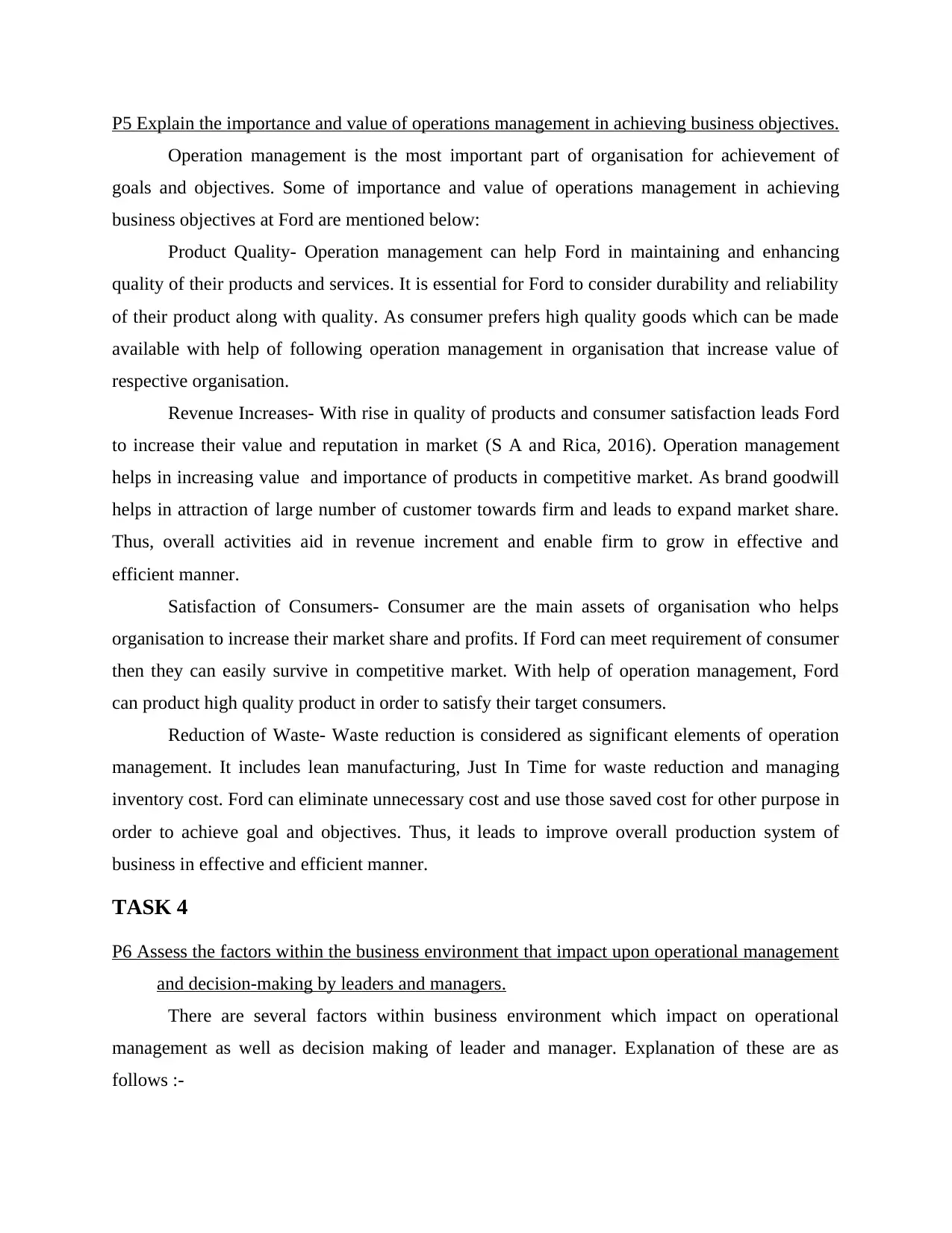
P5 Explain the importance and value of operations management in achieving business objectives.
Operation management is the most important part of organisation for achievement of
goals and objectives. Some of importance and value of operations management in achieving
business objectives at Ford are mentioned below:
Product Quality- Operation management can help Ford in maintaining and enhancing
quality of their products and services. It is essential for Ford to consider durability and reliability
of their product along with quality. As consumer prefers high quality goods which can be made
available with help of following operation management in organisation that increase value of
respective organisation.
Revenue Increases- With rise in quality of products and consumer satisfaction leads Ford
to increase their value and reputation in market (S A and Rica, 2016). Operation management
helps in increasing value and importance of products in competitive market. As brand goodwill
helps in attraction of large number of customer towards firm and leads to expand market share.
Thus, overall activities aid in revenue increment and enable firm to grow in effective and
efficient manner.
Satisfaction of Consumers- Consumer are the main assets of organisation who helps
organisation to increase their market share and profits. If Ford can meet requirement of consumer
then they can easily survive in competitive market. With help of operation management, Ford
can product high quality product in order to satisfy their target consumers.
Reduction of Waste- Waste reduction is considered as significant elements of operation
management. It includes lean manufacturing, Just In Time for waste reduction and managing
inventory cost. Ford can eliminate unnecessary cost and use those saved cost for other purpose in
order to achieve goal and objectives. Thus, it leads to improve overall production system of
business in effective and efficient manner.
TASK 4
P6 Assess the factors within the business environment that impact upon operational management
and decision-making by leaders and managers.
There are several factors within business environment which impact on operational
management as well as decision making of leader and manager. Explanation of these are as
follows :-
Operation management is the most important part of organisation for achievement of
goals and objectives. Some of importance and value of operations management in achieving
business objectives at Ford are mentioned below:
Product Quality- Operation management can help Ford in maintaining and enhancing
quality of their products and services. It is essential for Ford to consider durability and reliability
of their product along with quality. As consumer prefers high quality goods which can be made
available with help of following operation management in organisation that increase value of
respective organisation.
Revenue Increases- With rise in quality of products and consumer satisfaction leads Ford
to increase their value and reputation in market (S A and Rica, 2016). Operation management
helps in increasing value and importance of products in competitive market. As brand goodwill
helps in attraction of large number of customer towards firm and leads to expand market share.
Thus, overall activities aid in revenue increment and enable firm to grow in effective and
efficient manner.
Satisfaction of Consumers- Consumer are the main assets of organisation who helps
organisation to increase their market share and profits. If Ford can meet requirement of consumer
then they can easily survive in competitive market. With help of operation management, Ford
can product high quality product in order to satisfy their target consumers.
Reduction of Waste- Waste reduction is considered as significant elements of operation
management. It includes lean manufacturing, Just In Time for waste reduction and managing
inventory cost. Ford can eliminate unnecessary cost and use those saved cost for other purpose in
order to achieve goal and objectives. Thus, it leads to improve overall production system of
business in effective and efficient manner.
TASK 4
P6 Assess the factors within the business environment that impact upon operational management
and decision-making by leaders and managers.
There are several factors within business environment which impact on operational
management as well as decision making of leader and manager. Explanation of these are as
follows :-
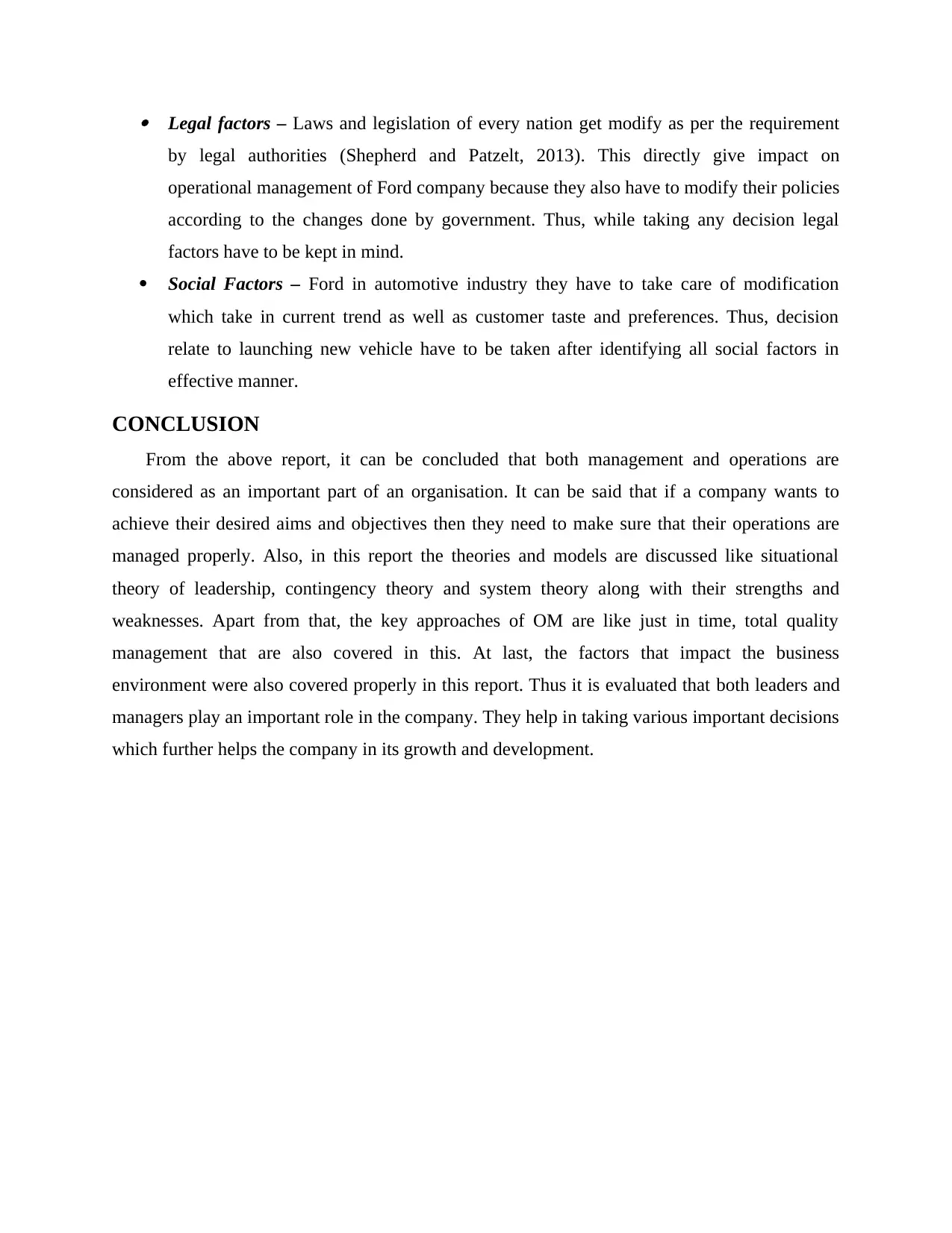
Legal factors – Laws and legislation of every nation get modify as per the requirement
by legal authorities (Shepherd and Patzelt, 2013). This directly give impact on
operational management of Ford company because they also have to modify their policies
according to the changes done by government. Thus, while taking any decision legal
factors have to be kept in mind.
Social Factors – Ford in automotive industry they have to take care of modification
which take in current trend as well as customer taste and preferences. Thus, decision
relate to launching new vehicle have to be taken after identifying all social factors in
effective manner.
CONCLUSION
From the above report, it can be concluded that both management and operations are
considered as an important part of an organisation. It can be said that if a company wants to
achieve their desired aims and objectives then they need to make sure that their operations are
managed properly. Also, in this report the theories and models are discussed like situational
theory of leadership, contingency theory and system theory along with their strengths and
weaknesses. Apart from that, the key approaches of OM are like just in time, total quality
management that are also covered in this. At last, the factors that impact the business
environment were also covered properly in this report. Thus it is evaluated that both leaders and
managers play an important role in the company. They help in taking various important decisions
which further helps the company in its growth and development.
by legal authorities (Shepherd and Patzelt, 2013). This directly give impact on
operational management of Ford company because they also have to modify their policies
according to the changes done by government. Thus, while taking any decision legal
factors have to be kept in mind.
Social Factors – Ford in automotive industry they have to take care of modification
which take in current trend as well as customer taste and preferences. Thus, decision
relate to launching new vehicle have to be taken after identifying all social factors in
effective manner.
CONCLUSION
From the above report, it can be concluded that both management and operations are
considered as an important part of an organisation. It can be said that if a company wants to
achieve their desired aims and objectives then they need to make sure that their operations are
managed properly. Also, in this report the theories and models are discussed like situational
theory of leadership, contingency theory and system theory along with their strengths and
weaknesses. Apart from that, the key approaches of OM are like just in time, total quality
management that are also covered in this. At last, the factors that impact the business
environment were also covered properly in this report. Thus it is evaluated that both leaders and
managers play an important role in the company. They help in taking various important decisions
which further helps the company in its growth and development.
⊘ This is a preview!⊘
Do you want full access?
Subscribe today to unlock all pages.

Trusted by 1+ million students worldwide
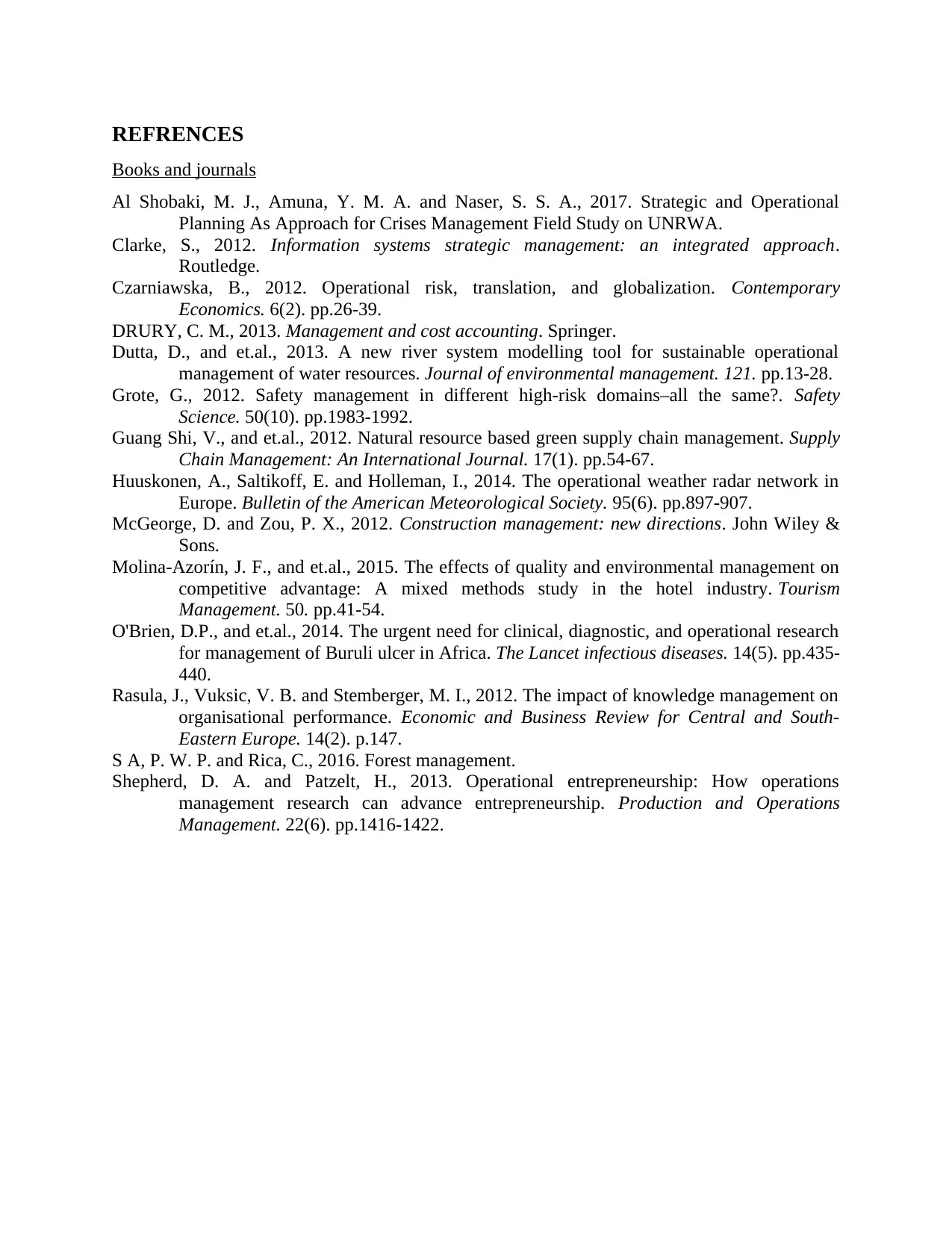
REFRENCES
Books and journals
Al Shobaki, M. J., Amuna, Y. M. A. and Naser, S. S. A., 2017. Strategic and Operational
Planning As Approach for Crises Management Field Study on UNRWA.
Clarke, S., 2012. Information systems strategic management: an integrated approach.
Routledge.
Czarniawska, B., 2012. Operational risk, translation, and globalization. Contemporary
Economics. 6(2). pp.26-39.
DRURY, C. M., 2013. Management and cost accounting. Springer.
Dutta, D., and et.al., 2013. A new river system modelling tool for sustainable operational
management of water resources. Journal of environmental management. 121. pp.13-28.
Grote, G., 2012. Safety management in different high-risk domains–all the same?. Safety
Science. 50(10). pp.1983-1992.
Guang Shi, V., and et.al., 2012. Natural resource based green supply chain management. Supply
Chain Management: An International Journal. 17(1). pp.54-67.
Huuskonen, A., Saltikoff, E. and Holleman, I., 2014. The operational weather radar network in
Europe. Bulletin of the American Meteorological Society. 95(6). pp.897-907.
McGeorge, D. and Zou, P. X., 2012. Construction management: new directions. John Wiley &
Sons.
Molina-Azorín, J. F., and et.al., 2015. The effects of quality and environmental management on
competitive advantage: A mixed methods study in the hotel industry. Tourism
Management. 50. pp.41-54.
O'Brien, D.P., and et.al., 2014. The urgent need for clinical, diagnostic, and operational research
for management of Buruli ulcer in Africa. The Lancet infectious diseases. 14(5). pp.435-
440.
Rasula, J., Vuksic, V. B. and Stemberger, M. I., 2012. The impact of knowledge management on
organisational performance. Economic and Business Review for Central and South-
Eastern Europe. 14(2). p.147.
S A, P. W. P. and Rica, C., 2016. Forest management.
Shepherd, D. A. and Patzelt, H., 2013. Operational entrepreneurship: How operations
management research can advance entrepreneurship. Production and Operations
Management. 22(6). pp.1416-1422.
Books and journals
Al Shobaki, M. J., Amuna, Y. M. A. and Naser, S. S. A., 2017. Strategic and Operational
Planning As Approach for Crises Management Field Study on UNRWA.
Clarke, S., 2012. Information systems strategic management: an integrated approach.
Routledge.
Czarniawska, B., 2012. Operational risk, translation, and globalization. Contemporary
Economics. 6(2). pp.26-39.
DRURY, C. M., 2013. Management and cost accounting. Springer.
Dutta, D., and et.al., 2013. A new river system modelling tool for sustainable operational
management of water resources. Journal of environmental management. 121. pp.13-28.
Grote, G., 2012. Safety management in different high-risk domains–all the same?. Safety
Science. 50(10). pp.1983-1992.
Guang Shi, V., and et.al., 2012. Natural resource based green supply chain management. Supply
Chain Management: An International Journal. 17(1). pp.54-67.
Huuskonen, A., Saltikoff, E. and Holleman, I., 2014. The operational weather radar network in
Europe. Bulletin of the American Meteorological Society. 95(6). pp.897-907.
McGeorge, D. and Zou, P. X., 2012. Construction management: new directions. John Wiley &
Sons.
Molina-Azorín, J. F., and et.al., 2015. The effects of quality and environmental management on
competitive advantage: A mixed methods study in the hotel industry. Tourism
Management. 50. pp.41-54.
O'Brien, D.P., and et.al., 2014. The urgent need for clinical, diagnostic, and operational research
for management of Buruli ulcer in Africa. The Lancet infectious diseases. 14(5). pp.435-
440.
Rasula, J., Vuksic, V. B. and Stemberger, M. I., 2012. The impact of knowledge management on
organisational performance. Economic and Business Review for Central and South-
Eastern Europe. 14(2). p.147.
S A, P. W. P. and Rica, C., 2016. Forest management.
Shepherd, D. A. and Patzelt, H., 2013. Operational entrepreneurship: How operations
management research can advance entrepreneurship. Production and Operations
Management. 22(6). pp.1416-1422.
1 out of 10
Related Documents
Your All-in-One AI-Powered Toolkit for Academic Success.
+13062052269
info@desklib.com
Available 24*7 on WhatsApp / Email
![[object Object]](/_next/static/media/star-bottom.7253800d.svg)
Unlock your academic potential
Copyright © 2020–2025 A2Z Services. All Rights Reserved. Developed and managed by ZUCOL.





